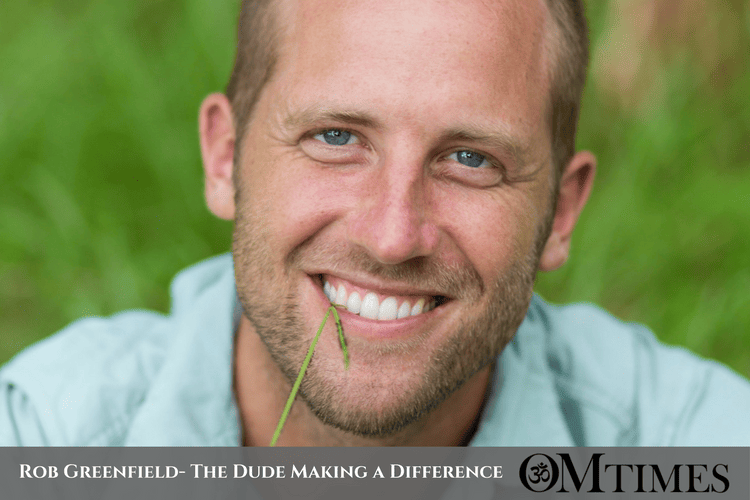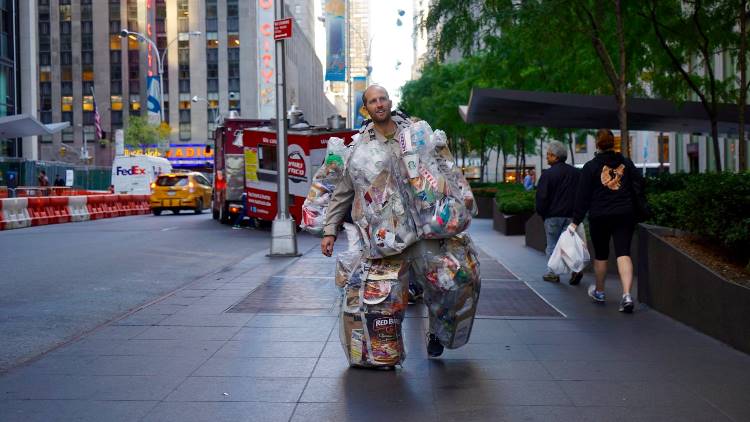Rob Greenfield: The Dude Making a Difference

 But anyway, we don’t see how, I mean literally in the United States there is a population of about 320 million Americans, but we waste enough food to feed another entire America. What that means is we produce enough food to feed about 600 million Americans. And because of this system that we’ve created of disposing of it, it’s just not something that really crosses our radar.
But anyway, we don’t see how, I mean literally in the United States there is a population of about 320 million Americans, but we waste enough food to feed another entire America. What that means is we produce enough food to feed about 600 million Americans. And because of this system that we’ve created of disposing of it, it’s just not something that really crosses our radar.
Food waste is actually one of the biggest environmental issues of our time. When you waste food, you also waste all of the water used to produce that food, all of the land that the food was grown on, all of the work hours, all of the pesticides, and the herbicides, and the fungicides. The people working, for $5 an hour spraying those pesticides that have higher rates of cancer, for nothing. So that’s, what’s happening when we’re wasting food.
Sandie Sedgbeer: Throughout Europe, many big supermarkets are now changing the way that they deal with food that is approaching or past its sell-by date and have all kinds of initiatives in place to address that issue. But you did a wonderful campaign to draw attention to this, which was 30 Days of Trash. Tell us a little about that.
Rob Greenfield: Yeah, so I like to come up with very visual ways to catch people’s attention and get them to think about important issues. As far as our individual waste that we create, again, it’s out of sight, out of mind. We put it in the trashcan, and the garbage man comes and picks it up, and we never really see how much it adds up to. So, I thought how can I create a visual that will really help people to like see how much trash we create and wrap their heads around it. And so I thought what better way than living like the average person, just like, eating, shopping, consuming like the average person does, but with the catch that I had to wear every piece of trash that I created. That way I wouldn’t be yelling at anybody. I would just be out there, kind of in people’s faces. I wouldn’t be telling anybody they had to listen. I was just doing it. And if they wanted to ask what it was that I was doing, they could. But anyway, the whole idea was just to create that vision. And it definitely worked. At the end of the month, I was wearing 87 pounds of trash, which is quite the sight.
Sandie Sedgbeer: Yeah, and quite a lot to be carrying around. I mean, any woman would shriek in horror if she thought that she was carrying an extra 80+ pounds on her body. But when we think what we’re doing with that 80+ pounds that we all throw away every month, I mean the thought is just really horrific. But that, that certainly got a lot of attention. I mean I think you had media coverage in France and all over the world for that one. How do you come up with the ideas?
Rob Greenfield: Well, I find myself a lot of times the most inspired while I’m out on a long ride. And it’s just brainstorming. Constant brainstorming. I brainstorm with my girlfriend, Cheryl, quite a bit, and just whoever I’m hanging out with. I kind of am somebody who likes to be productive pretty much all the time. If I’m just hanging out with friends, I’m talking about ideas and running ideas past them.
So, for example, Trash Me, where I wore all my trash for a month, came from Super Size Me where Morgan Spurlock ate only McDonald’s for 30 days to bring attention to, the fast food industry.
So, I thought, how can I use this like idea and switch it over to, raising awareness about trash? I lived like the average American and wore all my trash, so Super Size Me, Trash Me. That was one of the big inspirations.
Sandie Sedgbeer: So for that entire month were you going against every rule that you made on that bike trip and eating normally, consuming electricity, water, power, everything, or were you just picking up trash and carrying it?
Rob Greenfield: No, that was the thing about this is that for the whole month. I was the opposite of me. My thing is paying attention to every action and trying to create as little trash as possible, and instead for the month what I did is I just lived like the average American. I went to the grocery store, I looked to see what was in other people’s shopping carts, and that’s what I bought. I would go to the restaurant, and I’d say what does everybody order? And that’s what I’d get.
I hadn’t eaten at McDonald’s for five years since back in the day when I wasn’t very conscious I ate fast food. So, day three I went to McDonald’s. I said what do you what do people get? And they said a Big Mac is the most common thing, so I ate a Big Mac. It was the first time I had that in, again, five years. And so, it was a very immersive and interesting experience that basically just flowed along in the breeze of American consumerism for a month, but I fully embraced it. I knew what I was getting into when I decided to do it.
Sandie Sedgbeer: So, and you didn’t just do this with trash. I mean you decided in 2014, to go moneyless. You made another trip across the USA without any money, and you’ve traveled abroad without any money. Tell us a little bit about how you did that because most people would think that’s impossible.
Rob Greenfield: Well, it was 2014 in the spring. Our society is so dependent upon money, there’s a saying, money makes the world go around. But it’s just something that I don’t believe is a reality. I think that it’s possible to live very, very good lives where money is either not a part of your life, or it’s a small part of your life.
To create something that would really get people thinking, my thing was that I landed in Panama with no money, with just the clothes on my back and my passport, and I had to make it all the way back to San Diego.
I had to pass through seven countries, through Costa Rica, Nicaragua, Honduras, El Salvador, Mexico, and really, I was two things, one, dependent on the kindness of others. I wanted to show that there are so many good people out there, contrary to what the news will say that it’s a dangerous, bloody place. And then secondly, it required me to be resourceful, and I think that’s one of the most important characteristics that we can work on is being resourceful because the thing is if you’re not resourceful, then you’ve got to be a consumer because you need to buy everything to solve your problems. You need to throw money at every situation, then you’re stuck in the money trap. But once you become resourceful and you realize the earth provides us with what we need if we only know how to use the resources wisely, then you’re able to really step outside of that trap. By traveling with no money, I was dependent upon the kindness of others but also dependent upon my resourcefulness to get me home.
Sandie Sedgbeer: Rob Greenfield, who lives a near zero waste lifestyle with just 111 possessions to his name and donates 100% of his media income to grassroots environmental nonprofits. You lived off the grid in a 50-square-foot tiny home in San Diego, California. What did that actually entail for you? What did you have to do to be completely off the grid?
Rob Greenfield: Well, basically. I think there’s a lot of confusion about what the word off-the-grid means because really what off-the-grid means is it means you’re off of the municipal public utilities, which is basically electric–electricity and water. So, a lot of people when they hear off-the-grid they think that means everything. It means you don’t have a Facebook account or, a computer, or that you’re some like, somewhat nonexistent citizen.
But off-the-grid, it just means that you have your own supply of energy and water and that you’re not using the literal grid, because that’s what it is, above and below us. The power lines are a grid, and the water is a grid. They’re arranged in a grid.
So, for water, I harvested all my water from the sky, from rainwater. That’s rainwater harvesting. And then for electricity, I had small solar panels. But I really did take it many steps further than living off-the-grid. The idea was to really have an as little environmental impact as possible while living in the city.
So, I simplified find my life down to not having a single bill to my name, not having a single debt, not having any credit cards. It’s been three years now, although I don’t live in a tiny house now; I’m traveling. But living in the tiny house was a really, really great experience of simple living in the city.
Sandie Sedgbeer: And not much bigger than what most people would use as a garden shed, and you had all your possessions. You harnessed energy from the sun. You created near zero waste, and you composted your own humanure, as it’s called. But then after a year of that, you auctioned off your little house and raised enough money to build 10 tiny houses for homeless San Diegans. How is that project going?
A veteran broadcaster, author, and media consultant, Sandie Sedgbeer brings her incisive interviewing style to a brand new series of radio programs, What Is Going OM on OMTimes Radio, showcasing the world’s leading thinkers, scientists, authors, educators and parenting experts whose ideas are at the cutting edge. A professional journalist who cut her teeth in the ultra-competitive world of British newspapers and magazines, Sandie has interviewed a wide range of personalities from authors, scientists, celebrities, spiritual teachers, and politicians.




